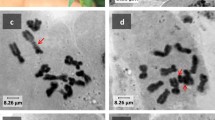Abstract
C-banded karyotypes of somatic chromosomes and meiotic abnormalities were investigated in four crown rust resistant lines derived from interploidy crosses in Avena.C-banding revealed that line N770-165-2-1 contained a 6C/21translocation while line DCS1789 contained a pair of A. strigosa chromosomes substituted for A. sativachromosome 12. Line JR2-3-3-B contained both the 6C/21 translocation and the pair of substituted A. strigosachromosomes, but line MAM17-4 contained neither. Although meiotic irregularities, including mispositioned bivalents, occurred in all four lines and in their F1 hybrids with A. sativa, the percentages of normal meiosis ranged from 75.4 to 88.6%. This allowed for stability of line performance and for their use as breeding stocks.
Similar content being viewed by others
References
Brown, C.M. & H.L. Shands, 1954. Behavior of the interspecific hybrid and amphiploid of Avena abyssinica × Avena strigosa. Agron J 46: 557–559.
Ellison, W., 1941. The cytology of certain diploid, triploid and tetraploid Avena hybrids. Genetika 22: 409–418.
Forsberg, R.A., 1990. The use of monosomic alien substitution lines in interploidy gene transfer in Avena. Bulgarian J Biotech 5–6: 27–30.
Forsberg, R.A. & H.L. Shands, 1969a. Breeding behavior of two Avena abyssinica × A. strigosa amphiploids. Crop Sci 9: 64–67.
Forsberg, R.A. & H.L. Shands, 1969b. Breeding behavior of 6xamphiploid × Avena sativa F1 hybrids. Crop Sci 9: 67–69.
Forsberg, R.A. & S. Wang, 1971. Cytogenetics of 6x-amphiploid × Avena sativa L. F1 hybrids. Can J Genet Cytol 13: 292–297.
Hulbert, S., T. Pryor, G. Hu, T. Richter & J. Drake. 1997. Genetic fine structure of resistance loci. In: I.R. Crute, E.B. Holub & J.J.Burdon (Eds), The Gene-for-Gene Relationship in Plant-Parasite Interactions, pp. 27–43. Wallingford, UK, CAB International.
Jellen, E.N. & B.S. Gill, 1996. C-banding variation in the Moroccan oat species Avena agadiriana (2n = 4x = 28). Theor Appl Genet 92: 726–732.
Jellen, E.N., R.L. Phillips & H.W. Rines, 1993. C-banded karyotypes and polymorphisms in hexaploid oat accessions (Avena spp.) using Wright's stain. Genome 36: 1129–1137.
Jellen, E.N., H.W. Rines, S.L. Fox, D.W. Davis, R.L. Phillips & B.S. Gill, 1997. Characterization of 'Sun II' oat monosomics through C-banding and identification of eight new 'Sun II' monosomics. Theor Appl Genet 95: 1190–1195.
Marshall, H.G. & W.M. Myers, 1961. A cytogenetic study of certain interspecific Avena hybrids and the inheritance of resistance in diploid and tetraploid varieties to races of crown rust. Crop Sci 1: 29–34.
Moustafa, M.A., R.A. Forsberg, A. Katsiotis & M.B. Dilkova, 1992. Cytogenetic and inheritance studies of crown rust resistant hexaploid oat translocation lines. In: A.R. Barr (Ed), Proc Fourth Int Oat Conf, pp. 131–133. Adelaide, Australia, Desktop Publishing.
Rajhathy, T. & H. Thomas, 1974. Cytogenetics of oats (Avena L.). pp. 19–33. Misc pub Genet Soc Canada, No. 2, Ottawa, Ontario.
Rayapati, P.J., J.W. Gregory, M. Lee & R.P.Wise, 1994a. A linkage map of diploid Avena based on RFLP loci and a locus confirming resistance to nine isolates of Puccinia coronata var. avenae. Theor Appl Genet 89: 831–837.
Rayapati, P.J., V.A. Portyanko & M. Lee, 1994b. Placement of loci for avenins and resistance to Puccinia coronata to a common linkage group in Avena strigosa. Genome 37: 900–903.
Sadanaga, K. & M.D. Simons, 1960. Transfer of crown rust resistance of diploid and tetraploid species to hexaploid oats. Agron J 52: 285–288.
Sharma, D.C., 1975. Chromosome pairing problems in interploidy transfer of leaf rust resistance in oats. Euphytica 24: 503–510.
Sharma, D.C. & R.A. Forsberg, 1974. Alien chromosome substitution-a cause of instability for leaf rust resistance in oats. Crop Sci 14: 533–536.
Sharma, D.C. & R.A. Forsberg, 1977. Spontaneous and induced interspecific gene transfer for crown rust resistance in Avena. Crop Sci 17: 855–860.
Thomas, H. & D.A. Lawes, 1968. Evaluation of the use of species hybrids and synthetic amphiploids in the improvement of the oat crop. Euphytica 17: 404–413.
Zillinsky, F.J., 1956. Cross compatibility relationships among some Avena species and polyploids. Can J Agr Sci 36: 107–113.
Zillinsky, F.J. & R.A. Derick, 1960. Crown rust resistant derivatives from crosses between autotetraploid Avena strigosa and A. sativa. Can J Plant Sci 40: 366–370.
Zillinsky, F.J., K. Sadanaga, M.D. Simons & H.C. Murphy, 1959. Rust resistant tetraploid derivatives from crosses between Avena abyssinica and A. strigosa. Agron J 51: 343–345.
Author information
Authors and Affiliations
Rights and permissions
About this article
Cite this article
Dilkova, M., Jellen, E. & Forsberg, R. C-banded karyotypes and meiotic abnormalities in germplasm derived from interploidy crosses in Avena . Euphytica 111, 175–184 (2000). https://doi.org/10.1023/A:1003855831536
Issue Date:
DOI: https://doi.org/10.1023/A:1003855831536




